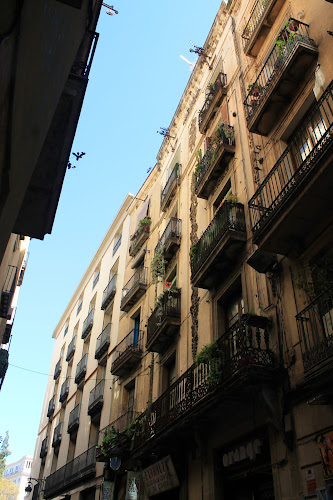Die Altstadt war immer noch Stadt, aber zu Beginn des letzten Jahrhunderts war sie das Letzte, schön und attraktiv war Barcelone nun in l'Eixemple. Und dann kam die Weltausstellung von 1929 und vorher wurde aufgeräumt, die Altstadt wurde saniert, geputzt, aufgehübscht und bekam einen alten Namen - Barri Gòtic.
Danach kam Franco, mit ihm der Bürgerkrieg, dann eine Weile nix und nach und nach verfiel das Viertel erneut und dann kam die Welt wieder zu Besuch, diesmal zum Sport, 1992 war Sommerolympiade in Barcelona und wieder wurde kräftig restauriert, saniert, erhalten. Und nach dem Sportfest kamen die Touristen, in Scharen, auch ich, zum dritten Mal bereits.
Und so ist der älteste Teil der Stadt eine Mischung aus Sozialwohnungen, asiatischen Ramschläden , spanischen Tapasbars ( ist hier was ausländisches, Barcelona ist die Hauptstadt von Katalonien), hippen Läden, teuren Boutiquen, Künstlertreffs, Galerien und Museen, in verwinkelten Gassen, kleinen Straßen und Plätzen, an denen früher Markt gehalten wurde und Heu, Fisch und Gemüse verkauft wurde. Es finden sich Spuren römischer Bebauung, große Kathedralen, kleine Geschäfte und freie Plätze zum Sitzen, Leute treffen, Kaffee trinken, Sardana tanzen.
Und wer es grad nicht bis Venedig schafft, eine Seufzerbrücke gibt es hier auch.
After that came Franco and the civil war in Spain, after that for a long run was nothing and step by step the quarter derelicted again and than the world came to visit once more, this time for sport, the Summer Games were held in Barcelona in 1992. And again they rebuild, refurbished, subtained. And after the sports festival came the tourists, in flocks, me too, for the third time already.
And so is the oldest part of the city now a mixture of social apartments, asian junk stores, spanish Tapas Bars ( that's something external here, Barcelona is the capitol of Catalonia), hip shops, expensive boutiques, meeting points for artists, galeries and museums, in small lanes, winding little streets and squares where in former times were markets selling hay, fish and vegetable. One can find traces of roman buildings, large cathedrals and small shops and places to sit and chat with people, drink a coffee or dance Sardana.
And for those, who can't it make to Venice, there is a Bridge of Sighs too.






































Keine Kommentare:
Kommentar veröffentlichen